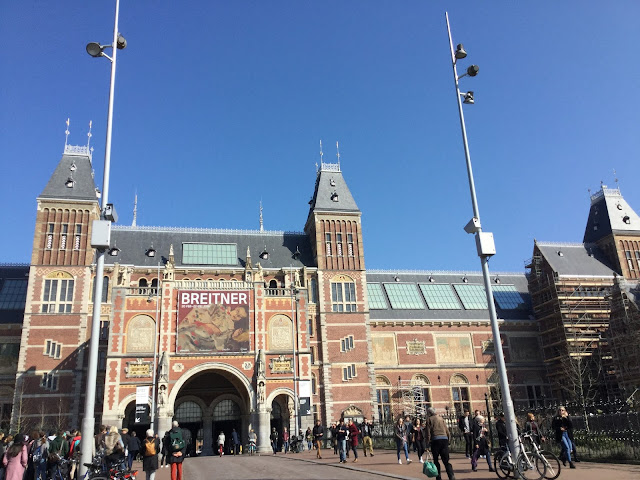 |
| Amsterdam Centraal |
I have been in The Netherlands for just over thirty-six hours. I could discuss how the Dutch are extremely friendly, warm, helpful, and just generally a content group of lovely people. I could tell you how easy public transit is to use and how bicycles rule the roads (that will be tomorrow's post!) I could write about the amazing art museums which have re-affirmed my love for Dutch art. Yes, when you're in Amsterdam you must visit the Van Gogh Museum and the Rijksmuseum.
 |
| Entrance to Rijksmuseum - a treasure of Dutch art! |
 |
| Great hall of the Rijksmuseum |
However, when one visits Europe, it's important to remember that this is a continent which has experienced two world wars in the last century. This fact is very much in the consciousness of the people here. Many Europeans are taught their history at a remarkably young age. One such historically important place in Amsterdam is the house where Anne Frank and her family hid.
The "Anne Frank Huis Museum" is located in one of the most beautiful parts of Amsterdam - flanked by canals and a stunning church. The story that the museum is preserving, however, is worth re-telling. It's worth taking an hour out of your holiday and becoming grounded in the reality of this place's history.
My visit to the Anne Frank House was touching due to many factors. Firstly, on such a gorgeous, sunny Spring day in Amsterdam - it is hard to imagine that a young girl and her family would be required to hide in darkness and silence inside, simply in order to survive. This is the kind of city where everyone cycles, children play football outside year-round, and people enjoy being active. The chance to grow up like this was robbed from young Anne Frank.
The Anne Frank House was also emotional because you clearly see that the dreams and talents were stolen from this young writer when she died in Bergen-Belsen Concentration Camp just months before it was liberated in 1945. As a Canadian, I have felt very welcome in Holland because of our role in liberating this country in World War Two. A visit to the Anne Frank House, however, clearly illustrated that for a great many - the liberation came too late.
 |
| Anne Frank's class - age 6. 15 children did not survive the Holocaust. |
The final reason that this museum had such a poignant effect on me is because of a photo in the final room of the exhibit. There is a very large class photo of Anne Frank when she is six years old. There are roughly twenty children in the class. The caption on the photo indicates the children's names, date of birth, and whether or not they survived the Holocaust. As an elementary school teacher, I was moved to tears looking at this class photo. Every year, I have a class photo and am quite confident that each face in the picture will grow up to be a contributing member of society. Over 80% of Anne's class did not survive the Holocaust. As I looked at their innocent faces, I could not imagine how evil could prevail on such a scale. Overcome with sadness, I left the museum quietly and walked along the canals as the sun set on what is now a modern, thriving, and gorgeous city.
 |
| Canal in Amsterdam at sunset |
 |
| Amsterdam - sunset |
 |
| The church beside Anne Frank Huis |
No comments:
Post a Comment